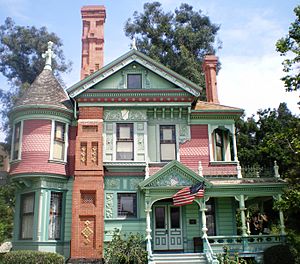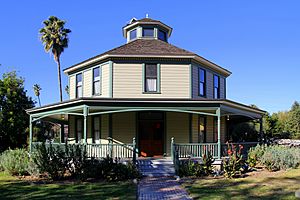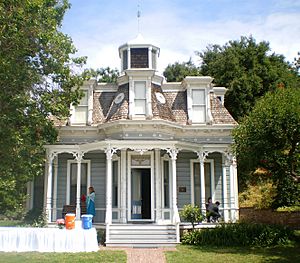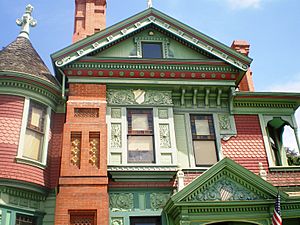Heritage Square Museum facts for kids

Hale House, Heritage Square Museum, Los Angeles
|
|
| Established | 1969 |
|---|---|
| Location | 3800 Homer Street Montecito Heights Los Angeles, California |
| Type | Historic house museum |
| Public transit access | Heritage Square |
Imagine stepping back in time! The Heritage Square Museum is a special place in Los Angeles, California. It's like an outdoor museum where you can see how people lived long ago.
This "living history" museum shows the story of how Southern California grew. It focuses on the years between 1850 and 1950. This was a century when Los Angeles changed a lot!
Friendly guides will take you on tours. They share stories about the history, buildings, and culture of the region. The museum also hosts special events and talks about the past.
Contents
- Saving History: How the Museum Started
- Historic Buildings You Can Explore
- Mount Pleasant House: A Grand Home
- The Palms Depot: A Train Station
- Longfellow-Hastings Octagon House: An Eight-Sided Home
- The John J. Ford House: A Carver's Home
- Lincoln Avenue Methodist Church: A Place of Worship
- Carriage Barn: For Horses and Carriages
- Valley Knudsen Garden Residence — Shaw House: A French Style Home
- Hale House: A Queen Anne Beauty
- The Salt Box: A Lost Treasure
- Images for kids
Saving History: How the Museum Started
In the 1960s, Los Angeles was growing very quickly. Many beautiful old Victorian buildings were being torn down. People wanted to build new things, but this meant losing important parts of history.
A program existed to identify important old buildings. However, it couldn't always stop them from being demolished. Because of this, a group of people decided to do something.
In 1969, they created the Cultural Heritage Foundation. Their goal was to save these special buildings. Heritage Square became a safe place for these historic homes. They were moved here to keep them from being destroyed.
Historic Buildings You Can Explore
Between 1969 and 2005, eight historic buildings were saved. A vintage train car and a trolley car were also moved here. These buildings now stand at Heritage Square. They help tell the story of Los Angeles.
Mount Pleasant House: A Grand Home
The Mount Pleasant House was built in 1876. A rich businessman named William Hayes Perry owned it. It was designed by a famous architect, Ezra F. Kysor.
This house shows how wealthy families lived. It has fancy details like Corinthian columns and beautiful hardwood floors. It also has a grand main staircase and marble fireplace mantles.
The house was once in a fashionable area called Boyle Heights. It was considered one of the finest homes in Los Angeles in the 1870s. Its style is called Victorian Italianate. In 1975, it was moved to the museum.
The Palms Depot: A Train Station
The Palms Depot was built around 1875. It was a train station for the Los Angeles and Independence Railroad. Later, it became part of the Pacific Electric Railway.
It served train passengers until 1953. This depot was recognized as a special historic place in 1963. To save it from being torn down, it was moved to the museum grounds.
Longfellow-Hastings Octagon House: An Eight-Sided Home
This octagon house is very unique. There are only about 500 eight-sided buildings left in the United States! The idea for these homes came from Orson Squire Fowler in the mid-1800s.
People who built octagon houses believed they were better. They thought eight sides meant more light and better air. This could save money on heating in winter and keep it cooler in summer. They also thought they were easier to build.
Most octagon houses were built in the eastern U.S. before the 1860s. So, this one, built in 1893, is quite unusual for its time. It was moved to the museum to be preserved.
The John J. Ford House: A Carver's Home
The Ford House was built in 1887. It was part of a group of homes for middle-class families in downtown Los Angeles. What makes this house special is who lived there.
John J. Ford was a famous wood carver. He created carvings for important places like the California State Capitol. Because of his job, the house has amazing, unique carvings inside and out.
Lincoln Avenue Methodist Church: A Place of Worship
The Lincoln Avenue Methodist Church was built in 1897. It was originally located in Pasadena. Its design mixes Carpenter Gothic and Queen Anne styles.
The inside layout is also interesting. It follows a special plan called the Akron style. This means the entrance is in one corner and the pulpit (where the speaker stands) is in the opposite corner.
Carriage Barn: For Horses and Carriages
This carriage barn was built in 1899. It was on the property of what is now Pasadena's Huntington Memorial Hospital. It belonged to Dr. Osborne, who worked at the hospital.
The barn has a Queen Anne Cottage style with some Gothic Revival influences. It has three gables and a distinct pitched roof. This barn was saved from demolition and moved to Heritage Square in 1981.
Valley Knudsen Garden Residence — Shaw House: A French Style Home
The Shaw House has a unique style for the West Coast. It's a Second Empire home with a French mansard roof. It's smaller than some of the other grand houses at the museum.
Hale House: A Queen Anne Beauty
The Hale House was built in 1887. It was built by George W. Morgan, who bought and sold land. It's a great example of the Queen Anne and Eastlake styles.
The house was moved a few times before James G. Hale bought it in 1906. The Hale family owned it until 1970, when the museum acquired it. The outside colors you see today are the original colors. The inside shows how the rooms might have looked in 1899.
The Salt Box: A Lost Treasure
The Salt Box was one of the last homes on Bunker Hill. It was also one of the first homes moved to Heritage Square. It was built in the Saltbox style.
Sadly, soon after it arrived, a fire destroyed it. Even though it's gone, it is remembered as a special historic monument.
Images for kids







